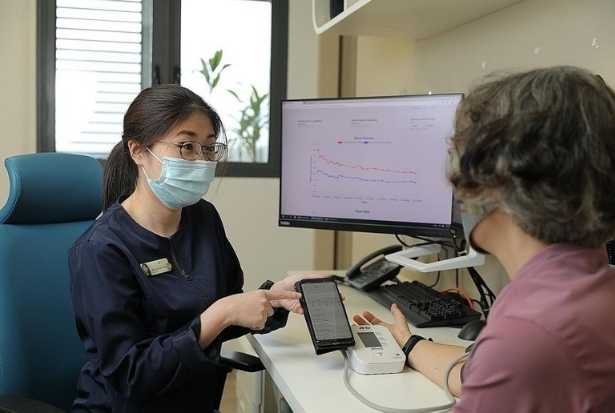Telemedicine has increased so significantly in the past year in the light of the pandemic that there seems to be no turning back.
And it is not just private telemedicine, but public healthcare institutions are stepping up as well.
Video consultations at such institutions are offered to more patients, including those with chronic conditions, post-surgery consultations, and long-term and palliative care. They can see their doctors online or even allied health professionals such as therapists.
Data from the Integrated Health Information Systems (IHiS), the technology agency for public healthcare institutions, shows that the use of video consultations in telemedicine continued to rise towards the end of last year.
Telemedicine is not a new concept. Pilots popped up more than a decade ago, and in 2017, video consultations were trialled at six public healthcare institutions.
But only 1,947 patients from public healthcare institutions here used the service between 2017 and the start of last year.
As the Covid-19 outbreak spread and many people stayed home, the impetus to offer such services grew and pilots began for different conditions. By October last year, 24,227 patients had sought medical help via video consultations.
This number reached at least 36,000 by January this year, noted IHiS data, while 125 public healthcare institutions held more than 7,500 video consultations in that month, up from 6,718 in October.
The 125 institutions include 14 public hospitals, polyclinics and public medical centres, plus social service agencies such as AWWA.
Only 53 such institutions offered telemedicine in January last year, and just 407 video consultations were done.
IHiS chief executive Bruce Liang said: "Usually, only review consult cases which are stable, where physical checks and tests are not required and where patients have appropriate devices and connectivity, will be recommended (for video consultations)."
Telemedicine can help tackle the problem of Singapore's overcrowded hospitals and specialist outpatient clinics, while patients benefit as they save time on travelling and waiting for appointments.
There are now many more telemedicine providers. The Ministry of Health has a voluntary listing of more than 600 direct telemedicine providers that have agreed to comply with certain measures, including that their doctors or dentists complete the ministry's telemedicine e-training.
Apart from the public hospitals, the providers include specialists clinics, general practitioner clinics and telemedicine firms such as WhiteCoat and Speedoc.
Speedoc said demand for its services is still rising. Raffles Medical Group, which launched its Raffles Connect App in early 2019, saw demand surge last year.
Although many people find face-to-face consultations irreplaceable, there is now a bigger group that is open to using telemedicine.
Before the pandemic, tele-medicine was piloted for disciplines such as mental health, renal medicine and pharmacy.
By January this year, 59 medical specialties across different institutions had applied to use video consultations, up from 23 a year earlier. The highest usage comes from psychiatry and chronic disease consultations, said Mr Liang.
The National Neuroscience Institute (NNI) started piloting video consultations at the start of last year for patients with epilepsy or dementia.
By March, as the pandemic disrupted the delivery of healthcare services, NNI expanded the use of video consultations to all suitable patients, regardless of their condition, said Dr Shermyn Neo, a consultant at its neurology department.
She said 345 patients at NNI's Neuroscience Specialist Outpatient Clinic who have conditions such as epilepsy or Parkinson's disease have done their review appointments online. Patient service associates at the clinic guide those who need help through the process.
Telemedicine can be particularly helpful to patients who are less mobile or those with learning disabilities who do not tolerate having to wait in the clinic, said Dr Neo.
The National University Health System (NUHS), which conducts more than 3,000 specialist outpatient and allied health teleconsultations each month, plans to expand its telehealth service to more patients, said group chief digital officer Peter Forbes.
Teleconsultations via video or phone calls are now offered only for repeat visits, and the level of physical assessment needed is one of the considerations when selecting patients for telehealth, he noted.
NUHS is working on videos to help patients use its telemedicine service, added Mr Forbes.
Dr Teng Gim Gee, head of Alexandra Hospital's Chronic Programme and lead of Telemedicine, said about 10 per cent of the hospital's patients have opted for telemedicine.
Older patients, in particular, may need more medical help but may not be IT-savvy or open to the idea.
Retiree Evelyn Teo, 67, who uses her mobile phone for online shopping, passed on the chance of a virtual consultation last year.
"I don't know how to see my doctor online. I prefer to just wear my mask and go to the hospital to see him. Everything is easier in person," she said in Mandarin.
1,947
Number of patients from public healthcare institutions who used video consultations between 2017 and the start of last year. In 2017, such consultations were trialled at six public healthcare institutions.
>7,500
Number of video consultations held at 125 public healthcare institutions in January this year.
Source: The Straits Times @ Singapore Press Holdings Limited | Reproduced with permission.
IHiS has rebranded as Synapxe, the national HealthTech agency. Read more about our new identity here.

